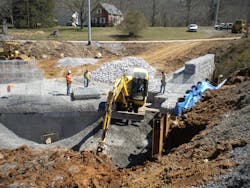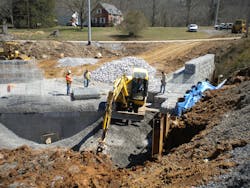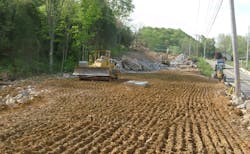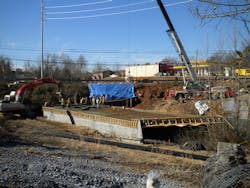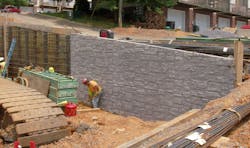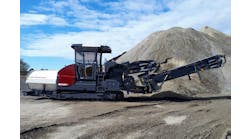By: Tim Bruns
Where could transportation officials turn to in the event of a serious incident on an interstate highway that required them to divert traffic elsewhere?
When it comes to I-26, the answer for the Tennessee Department of Transportation (TDOT) was S.R. 36, a corridor that parallels the interstate and serves as a bypass through Washington County, on the far east side of the state. “This corridor is a major connector between two of our more populated towns up here between Johnson City and Kingsport,” TDOT District Operations Manager Randy Busler told Roads & Bridges.
About five years ago, TDOT contracted with Summers-Taylor Inc., a paving contractor in Elizabethton, Tenn., to widen the then two-lane route to five lanes. The result would be a wider bypass for the interstate that could accommodate more traffic. “TDOT’s main reason for wanting it to be widened is of course overcrowding, but they’re also wanting it to be a secondary route to the interstate, a backup if it had to be shut down for any reason,” Scott Fuller, vice president of construction for Summers-Taylor, told Roads & Bridges.
The $46 million 3.9-mile project was funded through TDOT using federal STP funds with a state transportation funding match.
The sub-base on the S.R. 36 project in Washington County, Tenn., consisted of grade-D base stone (mostly limestone), while the base was mainly clay.
Moving things around
Work began in March 2012 on what would become the largest contract to date for Summers-Taylor, which has been in business since 1932. A majority of the initial work was dedicated to utilities, including relocation of sewer, gravity sewer, water, natural gas and all communication lines. “We had new electric and some communications were overhead; the rest of it was underground,” Fuller said. “And then during that time, we had to keep all the existing utilities in service. And the road was originally a two-lane road, so we had to keep it open.”
TDOT set up several temporary relocations for utilities to provide an opportunity for workers to carry out the widening process. Past unknown conflicts with some of the utilities provided a challenge for the TDOT team. “There were issues that came up that were not noted in the original plans,” Busler said. “We had to go back and go through a couple of redesigns to make sure we had clearance.”
In addition to relocating utilities, the teams at TDOT and Summers-Taylor had to install storm drainage on the project and extend four box culverts to accommodate the widening of the road. Also, cranes were used to construct seven retaining walls on the job of various types, including soldier pile walls, gravity walls and mechanically stabilized earth (MSE) modular walls.
Crews working during the early stages of the S.R. 36 project, which was recognized by NAPA for quality in construction.
Award-winning asphalt paving
Summers-Taylor was working with a minimum compaction requirement of 92%, and averaged about 7 miles in transporting distance from the asphalt plant. The team used a 7.5-in. sub-base of grade-D base stone, which was mainly limestone, while the base was primarily constructed of clay.
Four different mix layers of asphalt were implemented on the S.R. 36 project, beginning with a 3-in. layer of type 307-AS mix with a maximum aggregate size of 1.75 in. On top of that came a 3-in. layer of 307-A mix with the same maximum aggregate size as the AS mix, followed by a 2-in. layer of type 307-BM2 mix with a 1.25-in. max. aggregate size. Finally, the surface layer was a 1.25-in. 411-D layer with a .5-in. max. aggregate size.
The lab testing at the asphalt plant differed for each mix type. 307-AS and 307-A lab testing requirements were only a gradation check, which was sampled by a belt cut on the virgin aggregate and RAP belts. The 307-BM2 and 411-D required the contractor to test the mix for AC content and gradation using the NCAT oven, along with Marshall pills and rice tests for volumetrics. Those tests were done to determine lab air voids and maximum theoretical gravity.
The 307-A, 307-BM2 and 411-D also required density testing in the field. Even though TDOT checks the density with a nuclear gauge, the contractor tests the density through core samples during the control strip operation. The 307-AS mix did not require field testing.
The paving train on the project was led by a Roadtec 2500 Shuttle Buggy, followed by a Roadtec RP190 paver. An Ingersoll-Rand DD90 vibratory smooth drum roller came after as well as a Hamm HD 90I vibratory oscillating roller in the middle. The finish roller was a Bomag BW11AS static roller.
In total, the team at Summers-Taylor used about 86,000 tons of asphalt and a little over 100,000 tons of stone. The total IRI came in at 44.9. The daily quantities on the binder and BM2 mix were smaller quantities that needed to be done in smaller sections. “But when we came back and did our D mix, our surface mix, we were after probably 2,000 tons a day, which was one complete pull all the way,” Fuller said. “So we did one pull each day on it.”
The National Asphalt Pavement Association (NAPA) awarded Summers-Taylor with a Quality in Construction Award for excellence in construction of an asphalt pavement in 2017.
“In earning this Quality in Construction Award, Summers-Taylor has constructed a safe, quiet, smooth asphalt pavement,” NAPA Chairman Kevin Kelly said in a release.
Work included extending four box culverts to accommodate widening.
Avoiding a traffic fiasco
One of the major challenges in the overall construction process for the completion of the S.R. 36 project was managing traffic in a way that would minimize impact and maintain access to all the businesses and residential areas along the corridor, while still trying to maintain the job schedule.
“Being built under traffic, we did not have what I would call high-production rate days on this job because it was sort of piecemealed for the traffic control,” Busler said. “But we would come in of course and start with our base; once we got our bases in place, we would come in with our base layer of AS mix, and then follow that up probably the next day with the A mix, and then a couple days later come back with our BM mix so we could get traffic shifted.”
Busler added that TDOT ran the modified mix through the bulk of the project. Once the entire template was constructed for the entire project length, the team came in to put the final surface mix on at once.
Crews had to build the two outside lanes first in each direction, while keeping traffic moving through the middle of the corridor. At certain stages, traffic would get shifted back to the outside lanes, one lane in each direction, while all the work was put in the middle between traffic.
“At one point, when we put traffic in the outside lanes, because of the grade differences, we had to put a barrier wall up, and then at multiple points we had to have crossovers to get to the other side because in some places we had anywhere between 5-10 ft of grade change,” Fuller said. “It was a real challenge keeping service to the businesses, homeowners and residents on the road without any major accidents and any major injuries to our workers and the traveling public.”
Fuller added that at one point in the construction process, interstate traffic had to be diverted onto the project route, causing crews to shut down construction work in order to keep traffic moving through the area. “All the coordination between all our crews was great,” Fuller said. “They helped each other out. I’m very proud of the outcome.”
Crews also constructed a series of retaining walls of various types.
About The Author: Bruns is associate editor of Roads & Bridges.
